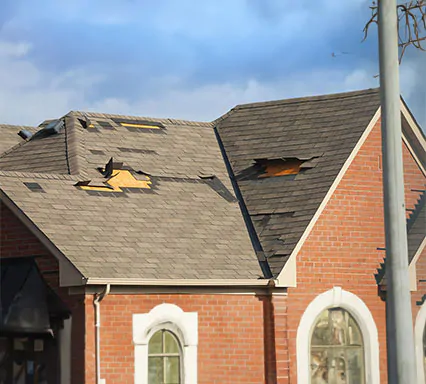Posted in:
Roof damage can happen suddenly due to a severe storm, fallen tree branches, or wear and tear over time. The damage to your roof can range from minor issues to significant problems that threaten the integrity of your home.
As a homeowner, it is important to quickly identify roof damage so it can be repaired before further issues develop. Understanding how to identify and address storm damage is essential to protecting your investment and ensuring the safety of your family.

Taking the right action after discovering roof damage can save you time, money, and stress. This article will provide a step-by-step guide as to what you should do after noticing damage to your home’s roof.
1. Prioritize Safety
Your top priority after noticing roof damage should be your and your family’s safety. If there is major damage to your home, such as large holes or leaks, you may want to consider evacuating the area until you can determine the extent of the situation.
Additionally, you may want to get right up on your roof following a storm to assess damage, if you are qualified and able. However, before inspecting your roof, it is crucial to identify potential safety hazards, such as downed power lines, weakened trees, or compromised structures. If in doubt, wait to get an assessment from a roofing professional.
2. Inspect Roof Damage
While it is recommended to avoid getting on the roof yourself unless you are qualified, you may be able to inspect the damage from the ground or a window.
Here are some signs of roof damage to look out for:
- Granule loss: Excessive granules in your downspouts or gutters can indicate shingle damage
- Missing or broken shingles: Be alert to areas where shingles are missing, curled, or cracked
- Damaged flashing: Inspect the metal flashing around your chimney, vents, or skylights for dents or cracks
- Debris: Large tree limbs or other debris on your roof can indicate impact damage
- Water stains on ceilings: Brown or yellow stains on your ceilings could indicate that your home’s roof is leaking
3. Document the Roof Damage
Take detailed photos of the damage to your roof and any infected areas inside your home. Take photos close up if possible and also from a distance to provide context.
These photos can provide evidence as they are a timestamped record of the roof damage when you go to file an insurance claim.
Additionally, you may want to jot down notes describing the damage and any measures you have taken to secure the damaged roof, such as covering it with a tarp.
4. Make Temporary Repairs
If it is safe to do so, make temporary repairs to prevent further water damage. This may include using a tarp or heavy plastic sheeting to cover any holes or areas where shingles are missing, preventing water from entering your home until professional repairs can be made.
You may want to secure the tarp with roofing nails to avoid further issues during windy conditions.
5. Contact a Roofing Contractor
After discovering roof damage, you will want to reach out to a reputable roofing contractor in your area. A professional roofer will conduct a thorough inspection and assess the extent of the damage.
Experienced roofing contractors can identify damage that may be overlooked by the untrained eye, such as microfractures, compromised structural components, and loosened seals.
A roofing contractor can give you an estimate for repairs and help you determine how quickly the work needs to be completed. The faster you get a professional roofer involved, the more likely you are to avoid further roof damage and more costly repairs.
6. Notify Your Home Insurance Company
You should notify your homeowner’s insurance company of the roof damage as soon as possible. Give a detailed explanation of the situation. Provide the insurer with the photos or videos you took of the damage, along with any documentation from your roofer.
Your insurance provider will likely send an adjuster to assess the damage and determine whether it is covered under your policy. Keep any receipts for temporary repairs or tarps, as these expenses may be reimbursed by your insurer.
7. Schedule Repairs
Depending on the severity of the damage, your roofing contractor will do either a full roof repair or a roof replacement. Any changes to the original estimate should be recorded in writing.
Once your home insurance company has approved your claim, or you decide to pay out-of-pocket, you can schedule the roof repairs with the contractor.
Throughout the process, do not hesitate to ask questions and stay informed about the progress of your repairs. Professional roofers will ensure their work adheres to industry standards and local building codes.
8. Prevent Future Storm Damage With Regular Maintenance
While swift action to repair or replace a damaged roof is vital, it is also important to take fast action to protect your roof against future damage. Keeping your roof in good repair can help you avoid the stress and expense of dealing with unexpected issues.
One way you could do this is by upgrading to impact-resistant materials, which offer higher resistance to storms and can save you from recurring repair expenses.
Additionally, scheduling regular roof inspections and maintenance can help you detect and address minor issues before they escalate. Regular maintenance includes tasks such as cleaning gutters and downspouts, trimming tree branches near your roof, and checking for signs of wear, such as missing or damaged shingles.
Contact Us for All Your Roofing Needs
At Cherry Roofing & Siding, we know that discovering roof damage can be a stressful experience, but acting quickly and following the steps in this article can help restore the safety and security of your home.
If you have discovered damage to your home’s roof, do not hesitate to contact our skilled team of roofing contractors. With close to 50 years of experience, we are knowledgeable and work hard to get the job done right.
Contact us today to schedule a free estimate. Our experienced roofing contractors will assess the damage, help you navigate the insurance process, and restore your roof to protect your home for years to come.
Oct 11, 2024







